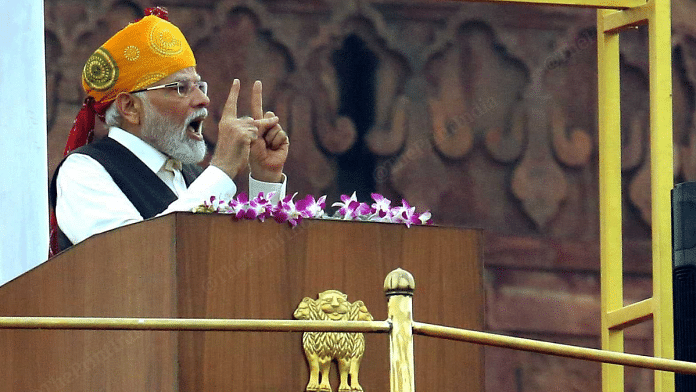New Delhi: Prime Minister Narendra Modi’s 10th Independence Day speech Tuesday suggested a significant change in his politics ever since he occupied the top post nine years ago.
In his Independence Day address in 2014, Modi was positive and warm towards political rivals who he had defeated barely three months before. He said that if the country had reached “such heights” after Independence, it was “because of the contributions of all the Prime Ministers, all the governments and even the governments in all the states.”
Talking about the Parliament session that had ended a day before, he said that the government was “not for moving forward on the basis of majority…. We want to move ahead on the basis of strong consensus”.
“From the ramparts of the Red Fort, quite proudly, I salute all the political parties…,” he had said.
That was in 2014. On Tuesday, the Prime Minister was virtually exhorting the people to “get rid” of his political adversaries from the ramparts of the Red Fort, identifying them with corruption, nepotism and appeasement. Dynastic parties are “a disease”, a “deformity” in Indian democracy, he said, adding, “Their life mantra is that their political party is of the family, by the family and for the family.” It was the first time that Modi chose his Independence Day address to directly attack opposition parties, making a sharp departure from his usual digs at past governments for their purported omissions and commissions.
Although the word ‘nepotism’ started figuring in his Independence Day speeches from 2017, he spoke it in a general sense without linking it with his political rivals. In 2022, he made it a point to clarify: “Whenever I talk about nepotism or dynasty, people think I am talking only in the context of politics. Not at all. Unfortunately, this political evil has nourished all institutions in Hindustan.” On Tuesday, he specified that he was laying “special emphasis on political parties” when he was talking about nepotism.
What was new about PM Modi’s Independence Day speech in 2023 was his reference to ‘tushtikaran’ or appeasement. Although he didn’t say ‘minority appeasement’, there was nothing left to imagination.
Leaders of the Bharatiya Janata Party (BJP) have, for long, been accusing the Congress and other secular parties of “appeasing” Muslims. “This appeasement has put a blot on our national character, our country’s fundamental philosophy…,” Modi said Tuesday.
It’s the first time that he — or any Prime Minister, for that matter — used the word ‘appeasement’ in the Independence Day address. In 2014, he had called for a 10-year “moratorium” on communalism, among other things”. In 2018, he had assured “Muslim mothers, sisters and daughters” that he wouldn’t stop until he freed them from the evil system of triple talaq. He delivered on it the very next year. His 10th Independence Day speech signaled a change in approach with the introduction of “‘appeasement”.
Also Read: 13.5 crore lifted out of poverty are now ‘new middle class’, says Modi in Independence Day speech
Changing focus over the years
Many things have changed since PM Modi delivered his first Independence Day speech. There were many subjects that figured in previous speeches only to fall into oblivion later. For instance, in 2014, the PM had announced the Sansad Aadarsh Gram Yojana, making it incumbent on each MP to develop one Model Village by 2016 and 5 such villages by 2024. “If we have to build a nation, we should start from the village,” Modi had said. Even BJP MPs don’t seem to remember the PM’s ambitious scheme now.
Speaking from the ramparts of the Red Fort in 2018, the last before the 2019 Lok Sabha election, PM Modi had declared his vision to double farmers’ income by the 75th year of Independence — that is, 2022. “Some people have doubts, which is quite natural. But we are determined. Hum makkhan par lakeer nahin, patthar par lakeer kheenchne waale hain (We draw lines on rocks, not butter),” he had said.
In his 2018 address, the PM had told the people that there was a time when news from the North-Eastern region used to be dominated by contents that one wished weren’t there. “Today, North-East is coming with inspiring stories…There was a time when the North-East used to feel that Delhi is very distant…We have brought Delhi to the North-East’s doorsteps,” he had said then. On Tuesday, he spoke about the spell of violence, loss of lives and violation of the dignity of mothers and daughters in Manipur, saying that the nation stands with the people of the state.
The texts of PM Modi’s Independence Day speech have naturally been changing since 2014, depending on the priorities of politics and governance. The 2023 speech, however, marks a significant shift with “appeasement” and “dynastic parties” entering the Independence Day speech of the Prime Minister.
That set the tone for the BJP’s campaign in the coming assembly polls running up to the 2024 Lok Sabha election.
(Edited by Tony Rai)
Also Read: ‘Democracy, Constitution & traditions threatened’ — Kharge attacks Modi govt in I-Day speech



